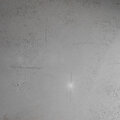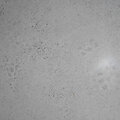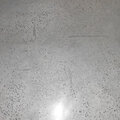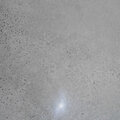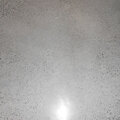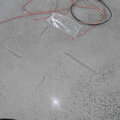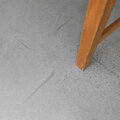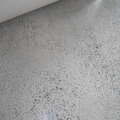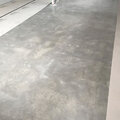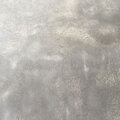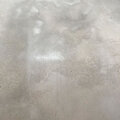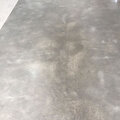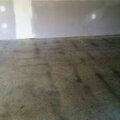Helicopter and Screed Marks - Nil or Light Exposure
A nil or light exposure polished concrete floor can be a desired look for those wanting to see very little, if any, aggregate in their floor. A plain, grey, concrete floor with very light exposure here and there can look great however in 1 out of 5 slabs the end result might not always be what the home or business owner initially anticipated.
The reason for this is because the quality of a nil or light exposure polished concrete floor is totally dependant on the workmanship of the concretor who poured and finished the slab.
Any blemishes or natural flaws that occur as part of the trowelling process will be visible as only 1-2mm of the surface is grinded away for light/nil exposure before polishing. Any further grinding (to remove marks) will expose patches of aggregate (stones) which goes beyond the whole concept and specification of nil or light exposure.
If the slab has not been prepared and helicoptered perfectly by the concretor the types of natural flaws that will be visible might include trowel and skreed marks, different coloured concreted areas, and random unexpected areas of denser aggregate exposure. These 'imperfections' or 'character marks' are common in nil/light exposure are not appreciated by home owners who are expecting a plain, even, grey, shiny concrete finish. It is for this reason that we will suggest that home owners opt for a random exposure or full exposure finish if there is any doubt in the integrity of the slab finish.
See the photos below for an idea of how helicopter marks, screed marks, boot marks, light grey patches and streaky lines can appear in this type of finish. These types of marks appear in perhaps 20% of nil to light exposure jobs. The amount of marks depend on the skill of the concretor who finishes the slab and has little to do with the concrete grinding and finishing process.
There are some home owners who enjoy these, let's call them unique, industrial or rustic marks in their floors, however for those who prefer a more consistent floor we recommend a random exposure or full exposure finish. Sometimes these marks only emerge toward the very end of the polishing process. Re-grinding and polishing a light exposure floor to remove these types of marks requires the entire polishing process to be re-started from scratch costing twice the amount in labour and equipment.
Take a look at the photos of the floor below to understand how important it is to hire a concretor who knows how perfect their workmanship must be if the slab is to be finalised in nil/light exposure without signature flaws or markings. Understand that a concrete polishing company cannot remove the marks as seen below without grinding further into the surface (which takes one into random exposure or full exposure territory!) Also understand that if you do not like your nil/light exposure finish, you will have to pay for your concrete floor to be machine ground and polished a second time.
Having said that, the couple who own the house of the floors below, had differing opinions about their finished floor. One partner was unhappy with the markings, the other partner actually liked the 'industrial' nature of the finish.
Nil or light exposure finishes will display these marks unless the most competent concretor is employed and the concrete is poured and finished to exacting standards.


